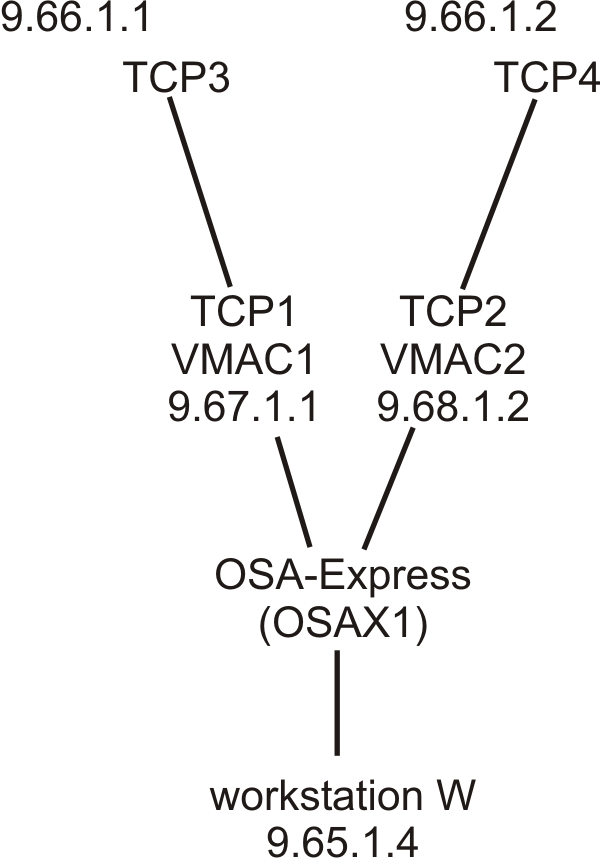 z/OS Communications Server: SNA Network Implementation Guide
z/OS Communications Server: SNA Network Implementation Guide
 z/OS Communications Server: SNA Network Implementation Guide
z/OS Communications Server: SNA Network Implementation Guide
|
Previous topic |
Next topic |
Contents |
Contact z/OS |
Library |
PDF
OSA-Express virtual MAC (VMAC) routing z/OS Communications Server: SNA Network Implementation Guide SC27-3672-01 |
|
|
If multiple TCP/IP instances are sharing an OSA-Express, the preferred method of routing is to define or generate a VMAC for each stack for each protocol being used (IPv4 or IPv6). For IPv4, this results in the OSA-Express using the VMAC address rather than the physical "burned in" MAC for all ARPs sent for that TCP/IP stack's registered IP addresses, and using the VMAC as the source MAC address for all packets sent from that stack. In this way, all routers on the same LAN as the OSA-Express will use only the VMAC address as the destination for all packets destined for that specific TCP/IP stack. From a network routing perspective, the OSA-Express with this VMAC will appear as a "dedicated" device to that TCP/IP stack. This simplifies a shared OSA configuration significantly. The OSA-Express knows by VMAC address exactly which stack should receive a given packet. Even if the IP address is not registered with the OSA-Express, if the packet is destined for that VMAC then the router has determined which stack should be the intermediate router, and the OSA can forward the packet directly to that stack. The capability is given for a stack to indicate to the OSA it only wishes to receive packets to registered IP addresses. The above simplification is true for IPv6 as well. TCP/IP will use the VMAC address for all neighbor discovery address resolution flows for that stack's IP addresses, and will likewise use the VMAC as the source MAC address for all IPv6 packets sent from that stack. Again, from a network perspective, the OSA-Express with this VMAC will appear as a "dedicated" device to that stack. The VMAC address may be defined in the stack, or if required may be generated by the OSA. If generated by the OSA, it is guaranteed to be unique from all other physical MAC addresses and from all other VMAC addresses generated by any OSA-Express feature. The following figure illustrates how OSA-Express virtual MAC routing works: Figure 1. OSA-Express virtual MAC
routing
 In this example, both TCP1 and TCP2 activate OSA-Express device OSAX1. TCP1 is defined with VMAC1 and TCP2 is defined with VMAC2. TCP1 registers each of its home IP addresses (just 9.67.1.1 in this example) to the OSA-Express device when the device is started on TCP1. The OSA-Express device indicates in all ARP processing that IP address 9.67.1.1 can be reached by using VMAC1. Similarly, TCP2 registers each of its home IP addresses (just 9.68.1.2 in this example) to the OSA-Express device when the device is started on TCP2, and again the OSA-Express device indicates in all ARP processing that IP address 9.68.1.2 can be reached by using VMAC2. If device OSAX1 receives any datagram destined to VMAC1, the OSA-Express routes that datagram to TCP1. So if routers determined either that IP address 9.66.1.1 or 9.67.1.1 could be reached by VMAC1, TCP1 receives packets destined to those addresses. Likewise, if device OSAX1 receives any datagram destined to VMAC2, the OSA-Express device routes those datagrams to TCP2. Therefore, if routers determined that either IP address 9.66.1.2 or 9.68.1.2 could be reached by VMAC2, TCP2 receives packets destined to those addresses. Rule: If VMACs are defined in the stack,
they should be defined as locally administered MAC addresses, and
should be a unique address for the local LAN on which they reside.
For IPv4, the VMAC is defined on the LINK statement of the MPCIPA
type DEVICE or the IPAQENET type INTERFACE statement representing
the shared OSA-Express. For IPv6, the VMAC is defined on the IPAQENET6
type INTERFACE statement representing the shared OSA-Express.
Guidelines:
You can define multiple interfaces to the same OSA for the same IP version by configuring multiple VLANs. To do this, configure a unique VLAN ID for each IPv4 interface over the OSA-Express and a unique VLAN ID for each IPv6 interface over the OSA-Express and configure (or generate) a unique VMAC for each INTERFACE statement. See z/OS Communications Server: IP Configuration Reference for how to define VMACs and VLANs in TCP/IP. See z/OS Communications Server: IP Configuration Guide for more considerations when using an OSA-Express configured in QDIO mode and for information about using multiple VLANs. See zEnterprise System and System z10 OSA-Express Customer's Guide and Reference for the level of OSA-Express2 that supports OSA-Express Virtual MACs. 


|
 Copyright IBM Corporation 1990, 2014 Copyright IBM Corporation 1990, 2014 |